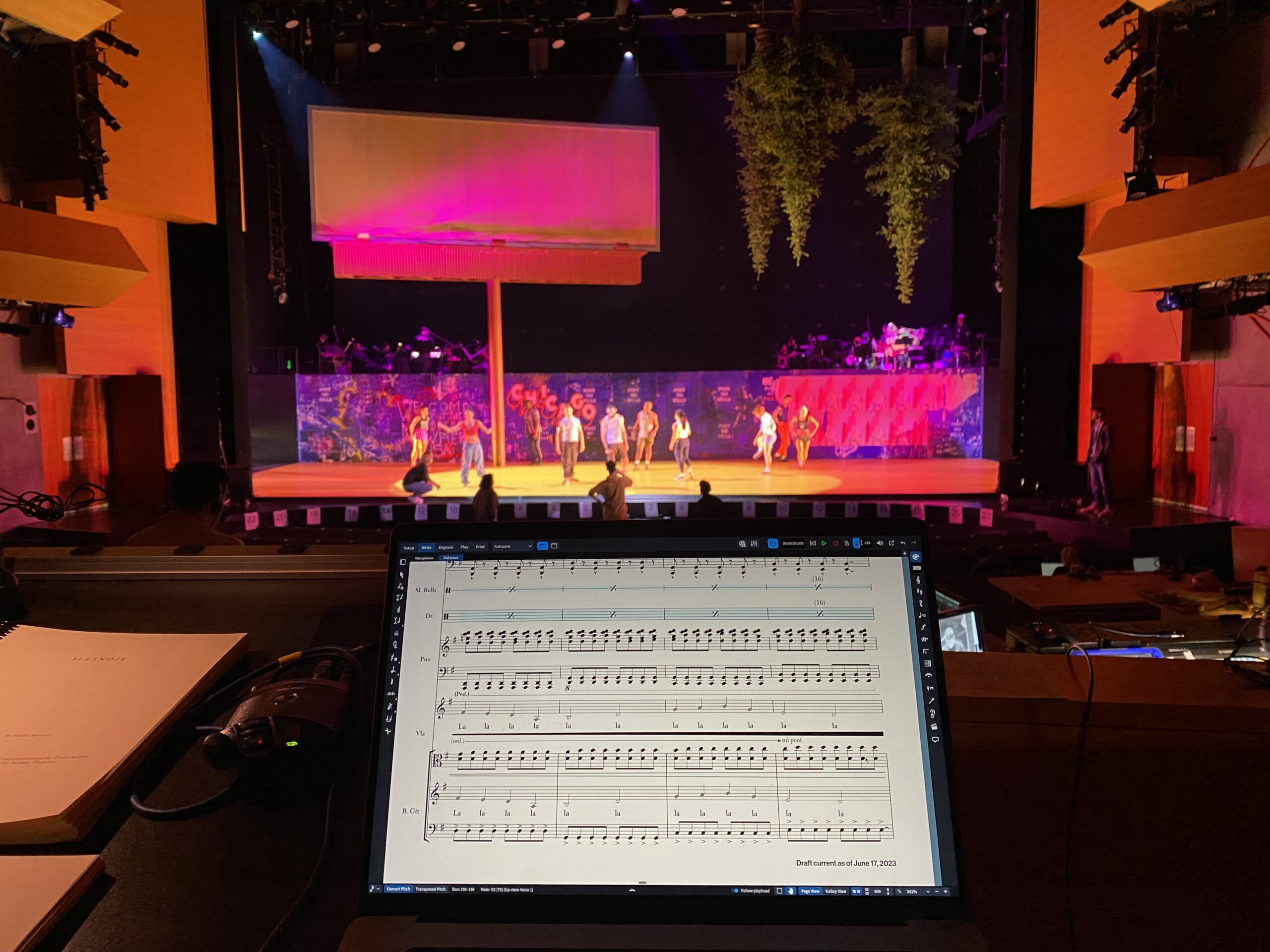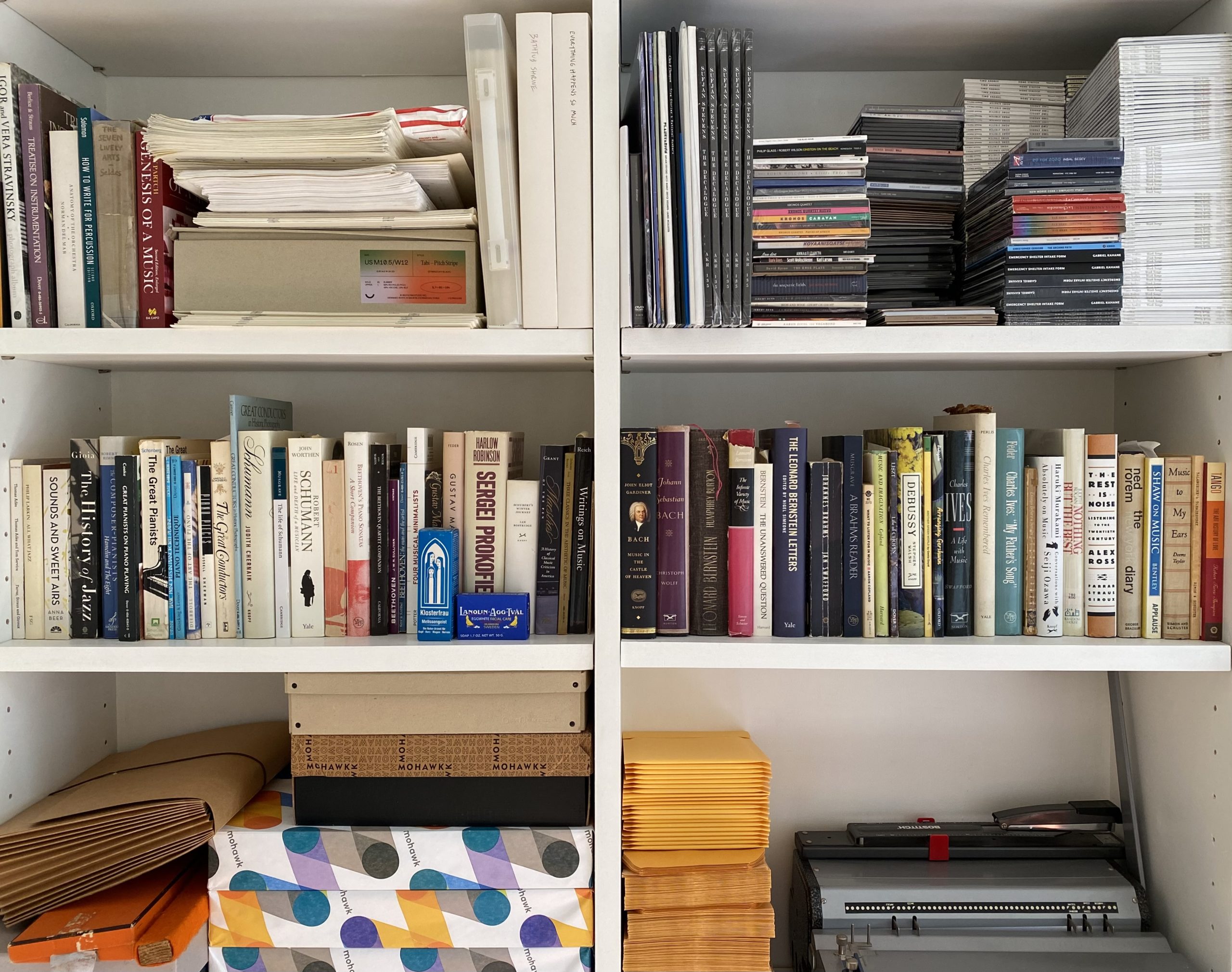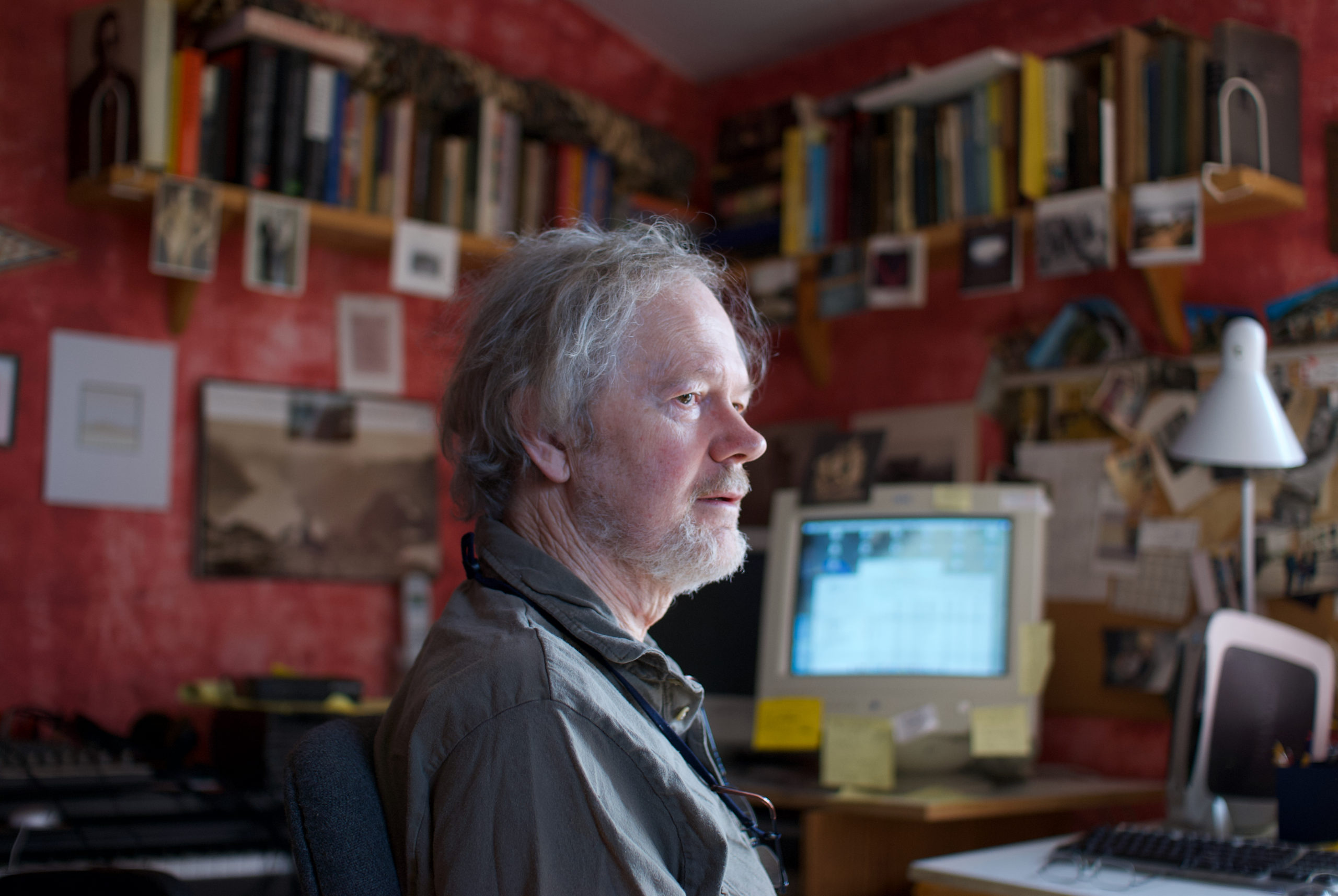
Here’s a real live music video for you, made during the recording session with cellist Inbal Segev for Agita a couple of years back. Jump cuts; jump scares, even! See me put my hand inside the piano and take it back out again.

Here’s a real live music video for you, made during the recording session with cellist Inbal Segev for Agita a couple of years back. Jump cuts; jump scares, even! See me put my hand inside the piano and take it back out again.

Above, the view from the music table during Illinois tech. The show opens Friday; things are sounding and looking stupdendous. It’s been a joy to spend time immersed in this music, with these people. If you missed your chance at tickets for this month’s run at Bard, never fear: future productions are materializing, including one in Chicago this winter.
I’ve had to tear myself away for a few days for a long-postponed jaunt to Britt Festival in Jacksonville, OR. I’ll join Teddy Abrams and the Britt Festival Orchestra for a performance of The Blind Banister on Thursday.

I’m very pleased to help trumpet the announcement of Sufjan Stevens’s new album Reflections, a two-piano ballet score that I recorded with Conor Hanick. The brilliant video above, directed by Brian Paccione, is a performance of the first track, Ekstasis. The full album is out May 19.
In other Sufjan-related news, I’ve created new arrangements and orchestrations for his 2005 album Illinois, which has been choreographed in its entirety by Justin Peck, premiering June 23 at Bard Summerscape.

Happy new year. In an heroic act of procrastination from writing, I’ve made a new subsection of this site listing the various things I’ve written about music over the years. Thanks to all the artists and record labels who have asked me to write about their recordings; doing so always teaches me new ways to listen and think about music.

I’m very pleased to present my new work for natural horn quartet, Loud Ciphers. The piece is somewhat atypical in that it was composed, recorded, filmed, and released over the course of just a month—a rare instance of immediate gratification in the usually glacial world of commissioning new work.
The piece was commissioned and performed by the extraordinary young natural horn specialist Isaac Shieh, who I was introduced to by Nico Muhly (thanks, Nico!). The above performance seems all the more remarkable with the knowledge that it was made during the past week’s intense European heat wave.
Here’s a bit more about the piece, and you can also purchase scores and parts.

I was honored to spend the past weekend remembering Ingram Marshall in an appraisal for the New York Times.
With an unlikely fusion of loose, stream-of-consciousness forms and old-school contrapuntal technique, he constructed monoliths of sound, then obscured them. He wove elaborate textures out of canons, inversions, elongations and diminutions. His gamelan-inspired arpeggios undulate gently in and out of sun and shadow. Frequent quotations and references give the music a sense of porousness and mutability. Everything coexists in what feels like a physical acoustic space — rich and reverberant, but also distant, held at a remove, seen through a dense fog. Above all, there is the emotional flavor of it. For him, music wasn’t just an abstraction, an intellectual game of pitches and forms. It was also about expressing something sincerely.
Read the full piece here.
Composer Danny Clay and The Living Earth Show collaborated on the album Music For Hard Times, for which I was honored to write the following liner note.
⁂
In March 2020, when composer Danny Clay wrote a series of eight Calming Strategies, his and other working musicians’ lives all over the world had suddenly come to a surreal and terrifying standstill. Clay had begun work on the Strategies trying to answer a seemingly simple question: how can composers and conservatory-trained instrumentalists use their specialized skills to help people feel better? And if the music they’re playing makes the musician feel something as they’re playing it, is there a way to transmit that same feeling to the listener?
The test harness for these strategies were Clay’s longtime collaborators Andy Meyerson and Travis Andrews, of the adventurous electric guitar and percussion duo The Living Earth Show. Andy and Travis spent the following weeks recording the 16 hours of raw material which became Music For Hard Times Book 1. In the process, they helped not just to refine Clay’s vision and notation, but to establish a timbral and gestural palette for subsequent realizations of the work. Those realizations would follow shortly. That winter, the duo enlisted the San Francisco Girls’ Chorus and students from the San Francisco Conservatory, two institutions eager to look beyond what had by then become rote multi-tracked online performances of standard repertoire. Here was a project that allowed their students room to experiment with process, collaborate with each other remotely, and create something new, reframing classical music’s traditional emphasis on faithful, polished execution of demanding scores. Music For Hard Times Book 2 emerged as the collective product of hundreds of hours of recordings by these scattered forces.
Clay constructed Book 2 like a generative collage or puzzle, first pairing sounds that felt as if they related to each other, layering them, and building outward from there. The Living Earth Show filled out these textures with yet more recordings, anchoring the ensemble from the back of the virtual stage in a kind of reverse concerto. They also acted as stewards of the piece’s oral tradition, coaching and guiding the students in their interpretations. In contrast to Book 1, the recordings from the chorus members and conservatory instrumentalists range broadly over not just instrumental timbres, but sound qualities, recording techniques, and acoustic environments. In some contexts this could be considered undesirable, if not downright unworkable, especially when recording so many tracks in isolation for a studio album. Clay deftly turned these gulfs in production values into yet another musical parameter to be considered, toyed with, and emotionally charged. Incidental noises, environmental sounds, intrusions that could be considered “imperfections” were encouraged. The solo cello which opens Book 2’s Epilogue feels homespun, slightly crude; there’s no vibrato on it, barely any reverb. It’s the plainest version of the A which has anchored the entire album. In contrast, the long, drawn-out cymbal rolls against a beatific choral background on Book 2 / Part 6 sound lush, detailed, expensive. In combining these elements, the finished product subverts our idea of what constitutes a “good recording”; hearing a sound recorded at a specific quality in a particular acoustic transforms it into an artifact of time and place. Book 2 is essentially a catalogue of individual spaces united in time—in many cases, recordings made literally during the same hours of January 2021, all over the world, then Dropbox-ed to Clay’s home studio in San Francisco.
The title acknowledges that times were hard in general, but hard for whom? The music itself bears neither a geopolitical nor a personal message. Rather, it serves a social purpose—communal self-care—making it Gebrauchsmusik (“music for use”). Taken together, the Calming Strategies and these realizations of them stand in quiet rebuke to the sleek, corporate rebranding of “self-care” that has taken place over the past decade. Instead of asking us to buy something, they invite us to make something for each other and for ourselves. But what, exactly, is being made? The original intention was to fashion a tool for musicians, and in turn, a balm for listeners at large. But it proved to be much more than that. As they recorded their initial realizations, Andy and Travis realized that the Calming Strategies were improving their own senses of well-being, too. It was not merely the distraction of having a project which felt somehow centering, but the specific qualities of the project itself. The Strategies themselves at times ask the player to use their own emotional responses as a gauge, and in doing so become a form of meditation. Strategy #1, for instance, is meant to last “slightly longer than you are comfortable, or until you feel it has made a significant effect on you”; #4 prompts to “add a small sound to your environment, to remind it you’re still there.”
These open-ended text instructions trace their roots back to the Fluxus movement, Pauline Oliveros’s Tuning Meditations, and Brian Eno’s Oblique Strategies. But from the outset, Clay was concerned less with conceptual rigor or novelty, and instead with producing a reliably beautiful result—and it is through the uncomplicated pleasures of making and listening to beautiful sounds that Music for Hard Times succeeds. There’s a clear timbral and harmonic palette that binds the album together. Especially in its larger choral-orchestral realization, there’s an ASMR-like detail to the sounds, an enveloping coziness which draws the listener inward. Clay plays games with the listener’s sense of space and distance, bringing a producer’s keen ear to the physical placement of each individual sample. In Part 1, a trio of intertwining melodies on flutes and cellos, close and detailed enough that they could be in the room with you, suddenly zooms out to a wide landscape of choral harmonies. These kinds of juxtapositions give the music a sense of perspective, and an immersive, three-dimensional depth. As we listen, we’re lifted out of our claustrophobic quarantine apartments and into the wider world, alongside the musicians themselves.
That one-to-one emotional relationship which Clay and the Living Earth Show originally set out to investigate is rare in pure music (that is, music without lyrics), because it’s an abstract language. There’s a fine line between giving people agency to experience the Calming Strategies for themselves, and nudging them in the direction of a musical narrative. That’s where Clay’s confident compositional hand becomes apparent. As befits the communal nature of the work, he takes a light touch, sublimating any sense of artist’s ego. Music For Hard Times rearranges and complicates the order of operations typically demanded by “composed” work, though it retains the core Classical Music triumvirate: composer, score, interpreters. Instead of producing a detailed document and giving it to performers to execute, Clay provides prompts, gathers responses, and then molds the result into just one of infinite possible “performances.” For this reason, it’s particularly educational to have two realizations to compare. Take Part 2 from both books; both employ Strategy #5 (“Pick one object, or musical idea. Record as many variations on it as you can”). Book 1’s treatment is a simple dialogue of a chord cycle in various inversions, while Book 2’s choral version is more discursive, voices swooping in from different directions, each breaking down a different melodic cell. It would be difficult, if not impossible, to identify both as having roots in the same “score.”
In this openness, Music For Hard Times stands in quiet opposition to the academic conservatory training its musicians possess. Classical music has always been, by nature, economically exclusive, locking the majority out of participating in it; in equipment and years of study, it costs hundreds of thousands of dollars for a bassoonist, say, to be able to play the opening of The Rite of Spring. Music For Hard Times continues a thread that runs through much of Clay’s work, which looks for ways to make the music accessible and applicable to anybody. Though written with the virtuosi of The Living Earth Show in mind, the work deepened its focus in moving beyond guitar and percussion. Adapting the strategies didn’t require changing them so much as broadening the language of the instructions to account for breath, so as to include singers and wind players, and the participation of students, amateur musicians, and even non-musicians (a few of the strategies contain notated music, but all have options for non-music readers to contribute as well).
Though its creators describe Music For Hard Times as a “New Age” album, the music is more experimental and adventurous than one might expect from such a label. Instead of spreading out on a flat, horizontal plane and acting as wallpaper, each track gently articulates emotional peaks and valleys. These aren’t evident in the wording or notation of the strategies themselves, which only shape the landscape by producing varied textures of music: melodies, sustained tones, loops, percussive events. Instead, these landscapes are the result of the composer shaping the performance after it’s taken place. It’s not quite narrative, but it is sculptural.
When composers speak of musical “architecture” we’re usually talking about form: what happens, when, for how long. But Music For Hard Times becomes a more literal sort of architecture in our minds as we participate in it; it’s a well-considered space to exist in for a while, one which merits attention without demanding it. In this way, the whole process functions as a bridge, connecting conservatory training to instrumental practice to what it means to be a human being. People become artists because of a deep and inexplicable urge to make things: for themselves, for each other, and for the wider world. As long as they are able to do this, they continue to grow and thrive. The Calming Strategies, and this specific documentation of them, function above all as a record of artists doing exactly that, during a memorably hard time.
–Timo Andres, July 2021

On Thursday, December 16th, I’ll be playing a solo recital on Kaufmann Center’s Piano Dialogues series. Lots of concert series have clever names like this but this program truly is a dialogue. My close friends Sarah Goldfeather and Eric Shanfield have written new pieces for me which will both be heard in public for the first time. Eric’s piece, Timo Variations, is a hefty set after a theme I composed for him in 2019. Here’s the theme—

—which Eric pleasantly eviscerates, in a series of sly and affectionate homages to other composers, among them: Schumann, Liszt, Brahms, Bach, Pärt, Webern, Ligeti, Nyman, and Glass.
Sarah’s new piece, called Fern Canyon, is a stunning pastorale, made up of tiny repeating patterns progressively stacked on each other. As it becomes an increasingly-complex thicket, the forest suddenly gives way to a dramatic vista.
In between, one of my favorite pastoral/metaphysical travelogues: Robert Schumann’s Waldszenen (Forest Scenes); in the video above, I play the cryptic Vogel als Prophet (Bird as Prophet).

The score to Honest Labor, my recent solo piano piece, is now available for purchase. The piece was premièred this past week in New York City by the fascinating and adventurous pianist Robert Fleitz.

Two good things occurring this coming Friday, May 21:
Chris Cerrone’s new album The Arching Path comes out on In A Circle Records. Above, a film we made for the title track with the brilliant fellows at Four/Ten Media. I’m honored to join a cast of real all-stars on the rest of the album: Lindsay Kesselman, Ian Rosenbaum, and Mingzhe Wang (whom longtime readers of this website will remember from his unimpeachable dumpling recipe). Jen Gersten wrote the insightful liner notes, and I designed the bright blue packaging.
Second and more pressingly: I am playing a solo program at Bargemusic that same night at 7; two tickets remain. Invite a friend from whom you’d like to sit some distance, and come hear some Southam, Adams, Schumann, Ellington, Debussy, Rorem, and Andres (Timo—me—the person writing this).